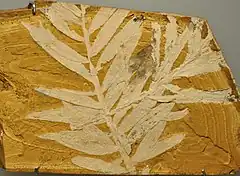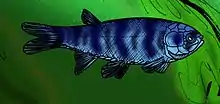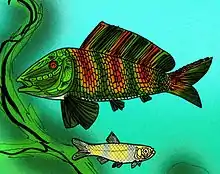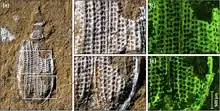Talbragar fossil site
The Talbragar fossil site is a paleontological site of Late Jurassic (Tithonian) age in the central west of New South Wales, Australia. It lies about 30 kilometres (19 mi) north-east of the town of Gulgong, and 300 kilometres (190 mi) north-west of Sydney. The site has been known for over a century during which it has been extensively excavated to the point of near exhaustion. It is now registered as a Crown Land Reserve for the preservation of fossils; access is by permit, and the collection of rocks and fossil specimens is prohibited.[2][3] The 4-hectare (9.9-acre) reserve is listed on the (now defunct) Register of the National Estate.
| Talbragar fossil site New South Wales | |
|---|---|
 Fossil fish Cavenderichthys talbragarensis from the Talbragar River | |
 Talbragar fossil site Location in New South Wales | |
| Nearest town or city | Gulgong |
| Coordinates | 32°10′S 149°48′E |
| Area | 4 hectares (9.9 acres) |
| Website | Talbragar fossil site |
| Footnotes | [1] |
| Designations | |
|---|---|
| Official name | Talbragar Reserve, Wonga Roo Rd, Ulan, NSW, Australia |
| Type | Natural |
| Designated | 28 September 1982 |
| Reference no. | 465 |
Fossils
The fossil-bearing rocks are fine-grained siltstones and mudstones that are part of the Purlawaugh Formation. They occur mainly as loose blocks and weathered shales over an area of about 300 by 80 metres (980 by 260 ft), with a thickness of no more than 60 centimetres (24 in). They are thought to be the remnants of sediments from a small freshwater lake, surrounded by forest, which existed about 175 million years ago when Australia was part of Gondwana. The site is the only Jurassic fish site known in New South Wales.[2]
The fossil material consists principally of the fishes that lived in the lake, as well as plants from the forest, whose remains accumulated in the sediments on the lake bed and were preserved. Among the many species discovered are sixteen kinds of plant, such as the conifer Agathis jurassica, eight kinds of fish, several insects, and a spider.[2]
Flora
| Flora of the Talbragar fossil site | ||||||
|---|---|---|---|---|---|---|
| Genus | Species | Location | Stratigraphic position | Material | Notes | Images |
| "Agathis" | "A." jurassica | Conifer, most common plant in assemblage. Dubiously placed in Agathis, has subsequently been placed in Podozamites, though this combination is not validly published. |  | |||
| Elatocladus | E. australis | Conifer | ||||
| Brachyphyllum | Indeterminate | |||||
| Allocladus | A. cribbii, A. milneanus | |||||
| ?Rissikia | ?Rissikia talbragarensis | |||||
| ?Pagiophyllum | ?Pagiophyllum peregrinum | |||||
| Rintoulia | R. pinnata | Seed fern | ||||
| Komlopteris[4] | K. purlawaughensis | |||||
| Nilssonia | N. compta | |||||
| Pentoxylales | Multiple | Represented by leaves (Taeniopteris), pollen organs (Carnoconites) and seed bearing organ (Sahnia) | ||||
Molluscs
| Molluscs of the Talbragar fossil site | ||||||
|---|---|---|---|---|---|---|
| Genus | Species | Location | Stratigraphic position | Material | Notes | Images |
| Proviviparus[5] | P. talbragarensis | A viviparid snail | ||||
Vertebrates
| Vetebrates of the Talbragar fossil site | ||||||
|---|---|---|---|---|---|---|
| Genus | Species | Location | Stratigraphic position | Material | Notes | Images |
| Aetheolepis[6] | A. mirabilis | A dapediid | ||||
| Aphnelepis[6] | A. australis | An archaeomaenid | ||||
| Archaeomaene[6] | A. tenuis | An archaeomaenid |  | |||
| Cavenderichthys[6] | C. talbragarensis | A orthogonikleithrid crown-group teleost. |  | |||
| "Coccolepis"[6] | "C." australis | A coccolepidid paleopterygian, not closely related to type species of genus | ||||
| Temnospondyli[7] | Indet | Tooth | ||||
| Uarbryichthys[6] | U. incertus, U. latus | A rare macrosemiiform actinopterygian. |  | |||
Arthropods
| Arthropods of the Talbragar fossil site | ||||||
|---|---|---|---|---|---|---|
| Genus | Species | Location | Stratigraphic position | Material | Notes | Images |
| Talbragaraneus | T. jurassicus | Uloborid spider | ||||
| Protochares | P. brevipalpis | Hydrophilid beetle | ||||
| Wongaroo | W. amplipectorale | Cerophytid beetle | ||||
| Talbragarocossus | T. jurassicus | Palaeontinid bug | ||||
| Beattieellus | B. jurassicus | Eucnemid beetle | ||||
| Rhopalomma | R. stefaniae | Ommatid beetle |  | |||
| Calosargus | C. (Calosargus) talbragarensis | Archisargid fly | ||||
| Gulgonga | G. beattiei | Praeaulacid wasp | ||||
| Juroglypholoma | J. talbragarense | Rove beetle | ||||
| Protachinus | P. minor | Rove beetle | ||||
| Talbragarus | T. averyi | Nemonychid weevil | ||||
| Austroprotolindenia | A. jurassica | Protolindeniid dragonfly | ||||
References
- "Talbragar Reserve, Wonga Roo Rd, Ulan, NSW, Australia (Place ID 465)". Australian Heritage Database. Australian Government. 28 September 1982. Retrieved 30 November 2017.
- "Talbragar". Fossil sites of Australia. Australian Museum. 22 September 2009. Retrieved 8 March 2011.
- Yong Yi Zhen (10 November 2018). "Fossils in Talbragar, NSW". The Australian Museum. Retrieved 9 May 2021.
- Slodownik, Miriam; Hill, Robert S.; McLoughlin, Stephen (October 2023). "Komlopteris: A persistent lineage of post-Triassic corystosperms in Gondwana". Review of Palaeobotany and Palynology. 317: 104950. doi:10.1016/j.revpalbo.2023.104950.
- Frese, Michael; Ponder, Winston (3 July 2021). "Proviviparus talbragarensis gen. et sp. nov., the first viviparid snail from the Late Jurassic of Australia". Alcheringa: An Australasian Journal of Palaeontology. 45 (3): 344–353. doi:10.1080/03115518.2021.1940276. ISSN 0311-5518. S2CID 238777174.
- Bean, L. B. (2017). "Reappraisal of Mesozoic fishes and associated invertebrates and flora from Talbragar and Koonwarra, eastern Australia". Proceedings of the Royal Society of Victoria. 129 (1): 7. doi:10.1071/rs17001.
- Hart, Lachlan J.; McCurry, Matthew R.; Frese, Michael; Peachey, Thomas J.; Brocks, Jochen (25 October 2021). "The first tetrapod remains from the Upper Jurassic Talbragar Fossil Fish Bed". Alcheringa: An Australasian Journal of Palaeontology. 45 (4): 423–428. doi:10.1080/03115518.2021.1983651. ISSN 0311-5518. S2CID 240026829.